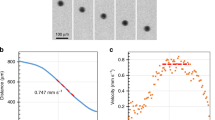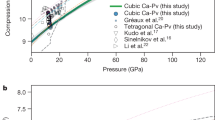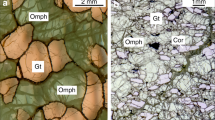Abstract
The oceanic asthenosphere is observed to have high electrical conductivity, which is highly anisotropic in some locations1,2. In the directions parallel and normal to the plate motion, the conductivity is of the order of 10-1 and 10-2 S m-1, respectively, which cannot be explained by the conductivity of anhydrous olivine2. But because hydrogen can be incorporated in olivine at mantle pressures3,4,5, this observation has been attributed to olivine hydration, which might cause anisotropically high conductivity by proton migration1,2,6,7. To examine this hypothesis, here we report the effect of water on electrical conductivity and its anisotropy for hydrogen-doped and undoped olivine at 500–1,500 K and 3 GPa. The hydrous olivine has much higher conductivity and lower activation energy than anhydrous olivine in the investigated temperature range. Nevertheless, extrapolation of the experimental results suggests that conductivity of hydrous olivine at the top of the asthenosphere should be nearly isotropic and only of the order of 10-2 S m-1. Our data indicate that the hydration of olivine cannot account for the geophysical observations2, which instead may be explained by the presence of partial melt elongated in the direction of plate motion.
This is a preview of subscription content, access via your institution
Access options
Subscribe to this journal
Receive 51 print issues and online access
$199.00 per year
only $3.90 per issue
Buy this article
- Purchase on Springer Link
- Instant access to full article PDF
Prices may be subject to local taxes which are calculated during checkout


Similar content being viewed by others
References
Karato, S. The role of hydrogen in the electrical conductivity of the upper mantle. Nature 347, 272–273 (1990)
Evans, R. L. et al. Geophysical evidence from the MELT area for compositional controls on oceanic plates. Nature 437, 249–252 (2005)
Bai, Q. & Kohlstedt, D. L. Substantial hydrogen solubility in olivine and implications for water storage in the mantle. Nature 357, 672–674 (1992)
Bell, D. R. & Rothman, G. R. Water in the earth’s mantle: the role of nominally anhydrous minerals. Science 255, 1391–1397 (1992)
Kohlstedt, D. L., Keppler, H. & Rubie, D. C. Solubility of water in the α, β and γ phases of (Mg,Fe)2SiO4 . Contrib. Mineral. Petrol. 123, 345–357 (1996)
Mackwell, S. J. & Kohlstedt, D. L. Diffusion of hydrogen in olivine: implications for water in mantle. J. Geophys. Res. 95, 5079–5088 (1990)
Kohlstedt, D. L. & Mackwell, S. J. Diffusion of hydrogen and intrinsic point defects in olivine. Z. Phys. Chem. 207, 147–162 (1998)
Huang, X., Xu, Y. & Karato, S. Water content in the transition zone from electrical conductivity of wadsleyite and ringwoodite. Nature 434, 746–749 (2005)
Xu, Y., Shankland, T. J. & Duba, A. G. Pressure effect on electrical conductivity of mantle olivine. Phys. Earth Planet. Inter. 118, 149–161 (2000)
Shankland, T. J. & Duba, A. G. Standard electrical conductivity of isotropic, homogeneous olivine in the temperature range 1200°-1500°C. Geophys. J. Int. 103, 25–31 (1990)
Wanamaker, B. J. & Duba, A. G. Electrical conductivity of San Carlos olivine along [100] under oxygen- and pyroxene-buffered conditions and implications for defect equilibria. J. Geophys. Res. 98, 489–500 (1993)
Hae, R., Ohtani, E., Kubo, T., Koyama, T. & Utada, H. Hydrogen diffusivity in wadsleyite and water distribution in the mantle transition zone. Earth Planet. Sci. Lett. 243, 141–148 (2006)
Hirschmann, M. M., Aubaud, C. & Withers, A. C. Storage capacity of H2O in nominally anhydrous minerals in the upper mantle. Earth Planet. Sci. Lett. 236, 167–181 (2005)
Mott, N. F. & Gurney, R. W. Electronic Processes in Ionic Crystals (Oxford Univ. Press, Oxford, 1948)
Wood, B. J., Btyndzia, L. T. & Johnson, K. E. Mantle oxidation state and its relationship to tectonic environment and fluid speciation. Science 248, 337–345 (1990)
Williams, H. M. et al. Iron isotope fractionation and the oxygen fugacity of the mantle. Science 304, 1656–1659 (2004)
Utada, H., Koyama, T., Shimizu, H. & Chave, A. D. A semi-global reference model for electrical conductivity in the mid-mantle beneath the north Pacific region. Geophys. Res. Lett. 30 1194 doi: 10.1029/2002GL016902 (2003)
Lizzarralde, D., Chave, A. D., Hirth, G. & Schultz, A. Northeastern Pacific mantle conductivity profile from long-period magnetotelluric sounding using Hawaii to California submarine cable data. J. Geophys. Res. 100, 17837–17854 (1995)
The MELT seismic team. Imaging the deep seismic structure beneath a mid-ocean ridge: The MELT experiment. Science 280, 1215–1218 (1998)
Jung, H. & Karato, S. Water-induced fabric transitions in olivine. Science 293, 1460–1463 (2001)
Presnall, D. C., Simmons, C. L. & Porath, H. Change of electrical conductivity of a synthetic basalt during melting. J. Geophys. Res. 77, 5665–5672 (1972)
Waff, H. S. & Bulau, J. R. Equilibrium fluid distribution in an ultramafic partial melt under hydrostatic conditions. J. Geophys. Res. 84, 6109–6114 (1979)
Roberts, J. J. & Tyburczy, J. A. Partial-melt electrical conductivity: Influence of melt composition. J. Geophys. Res. 104, 7055–7066 (1999)
Takahashi, E. Melting of a dry peridotite KLB-1 up to 14 GPa: Implications on the origin of peridotitic upper mantle. J. Geophys. Res. 91, 9367–9382 (1986)
Kushiro, I. et al. Melting of a peridotite nodule at high pressures and high water pressures. J. Geophys. Res. 73, 6023–6029 (1968)
Wyllie, P. J. & Huang, W-I. Influence of mantle CO2 in the generation of carbonatites and kimberlites. Nature 257, 297–299 (1975)
Wang, W. & Takahashi, E. Subsolidus and melting experiments of K-doped peridotite KLB-1 to 27 GPa: Its geophysical and geochemical implications. J. Geophys. Res. 105, 2855–2868 (2000)
Holtzman, B. K. et al. Melt segregation and strain partitioning: implications for seismic anisotropy and mantle flow. Science 301, 1227–1230 (2003)
Baba, K., Chave, A. D., Evans, R. L., Hirth, G. & Mckie, R. L. Mantle dynamics beneath the East Pacific Rise at 17°S: Insights from the Mantle Electromagnetic and Tomography (MELT) experiment. J. Geophys. Res. 111 B02101 doi: 10.1029/2004JB003598 (2006)
Dunn, R. A. & Forsyth, D. W. Imaging the transition between the region of mantle melt generation and the crustal magma chamber with short-period Love wave propagation along the southern East Pacific Rise. J. Geophys. Res. 108 B72352 doi: 10.1029/2002JB002217 (2003)
Acknowledgements
We thank K. Baba, K. Fujita, M. Ichiki, T. Koyama, E. Ito and D. Yamazaki for discussions, D. Kohlstedt for comments and suggestions that improved manuscripts, and C. Oka for technical assistance.
Author information
Authors and Affiliations
Corresponding author
Ethics declarations
Competing interests
Reprints and permissions information is available at www.nature.com/reprints. The authors declare no competing financial interests.
Supplementary information
Supplementary Notes
This file contains Supplementary Methods, Supplementary Discussion (a cause of lower activation energy for proton conductivity) and Supplementary Figure 1 (Electrical conductivity of hydrous olivine single crystals as a function of reciprocal temperature). (PDF 159 kb)
Rights and permissions
About this article
Cite this article
Yoshino, T., Matsuzaki, T., Yamashita, S. et al. Hydrous olivine unable to account for conductivity anomaly at the top of the asthenosphere. Nature 443, 973–976 (2006). https://doi.org/10.1038/nature05223
Received:
Accepted:
Issue Date:
DOI: https://doi.org/10.1038/nature05223
This article is cited by
-
Electrical conductivity measurements in piston cylinder press: metal shielding in the assembly design and implications
Contributions to Mineralogy and Petrology (2023)
-
Structural independence of hydrogen-bond symmetrisation dynamics at extreme pressure conditions
Nature Communications (2022)
-
Effect of second Si–O vibrational overtones/combinations on quantifying water in silicate and silica minerals using infrared spectroscopy, and an experimental method for its removal
Physics and Chemistry of Minerals (2022)
-
Atomistic insight into lithospheric conductivity revealed by phonon–electron excitations in hydrous iron-bearing silicates
Communications Materials (2021)
-
Bridging the water solubility and ion diffusivity in the mantle silicates by a thermodynamic model
Mineralogy and Petrology (2020)
Comments
By submitting a comment you agree to abide by our Terms and Community Guidelines. If you find something abusive or that does not comply with our terms or guidelines please flag it as inappropriate.



